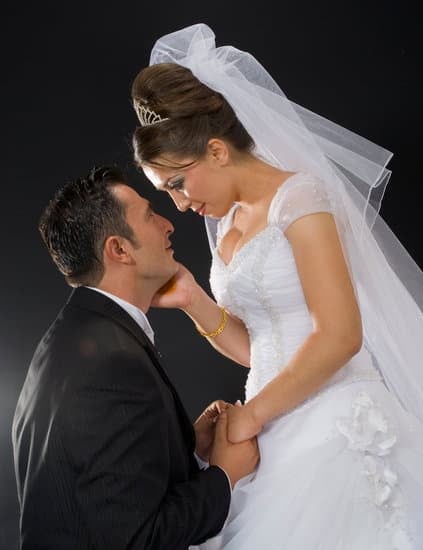How do I make a wedding veil? The wedding veil is a beautiful and traditional accessory that holds significant importance in a bride’s ensemble. It adds an element of romance, elegance, and tradition to the overall bridal look. In this article, we will explore the materials needed, fabric options, design choices, step-by-step instructions, and customization ideas for creating a custom wedding veil.
The wedding veil serves as a symbol of purity and modesty while also adding a touch of drama and mystique to the bride’s appearance. It has been a staple in bridal attire for centuries and continues to be an essential part of the wedding day attire. Whether it is a classic cathedral length veil or a shorter fingertip veil, the style chosen can greatly impact the bride’s overall look.
Creating your own wedding veil allows for personalization and customization to perfectly complement your dress and overall wedding theme. From choosing the right fabric to creating a unique design, making your own wedding veil can be both rewarding and cost-effective. In the following sections, we will provide detailed guidance on how to make your very own custom wedding veil, ensuring that it becomes a cherished part of your special day.
Materials Needed
Making your own wedding veil can be a fun and rewarding DIY project that adds a personal touch to your bridal ensemble. To get started, you will need to gather the necessary materials. Here is a detailed list of everything you will need to make your own wedding veil:
- Tulle or Netting: This will be the main fabric of your veil. Choose the length and color that best complements your wedding dress.
- Thread: Select a high-quality thread that matches the color of your tulle or netting.
- Comb or Headpiece: You will need something to attach the veil to, whether it’s a comb, headband, or tiara.
- Embellishments: If desired, consider adding lace, beads, sequins, or other decorative elements to adorn your veil.
- Measuring Tape: Essential for determining the length of your veil and ensuring precise cuts.
- Sewing Needles and Pins: Make sure you have needles suitable for sewing tulle and strong pins for securing fabric layers.
- Scissors: Sharp fabric scissors are crucial for cutting tulle cleanly and accurately.
Once you have gathered these materials, you will be ready to move on to the next steps in creating your custom wedding veil. With these supplies in hand, you can start envisioning the style and design options that will best suit your wedding dress and overall theme. Remember that making a wedding veil allows for endless creativity and personalization, so don’t hesitate to make this project entirely your own.
Whether you opt for a simple and classic design or choose to embellish your veil with intricate details, having all the necessary materials at hand is essential for bringing your vision to life. In the following sections of this guide, we will delve into selecting the right fabric for your veil, exploring various design options, and providing step-by-step instructions on how to cut, sew, and customize your very own wedding veil.
Choosing the Right Fabric
When it comes to making a wedding veil, choosing the right fabric is crucial as it can greatly impact the overall look and feel of the veil. There are several different fabric options to consider, each with its own unique properties and suitability for various styles of veils. One of the most popular choices for wedding veils is tulle, a lightweight netting that comes in different variations such as silk tulle, nylon tulle, and illusion tulle.
Silk tulle is known for its luxurious drape and softness, making it an excellent choice for classic and elegant veils. On the other hand, nylon tulle is more affordable and readily available, making it a practical option for budget-conscious brides. Illusion tulle is slightly stiffer than silk tulle but still maintains a soft appearance, often used for creating fuller or poufier veils.
Another fabric option to consider is lace, which adds a romantic and vintage touch to a wedding veil. Chantilly lace is delicate and features intricate floral patterns, perfect for creating a soft and ethereal look. Alençon lace, on the other hand, has bolder motifs and scalloped edges, ideal for adding drama and glamour to the veil.
Additionally, if you’re looking for something more unconventional, consider using organza or chiffon for your wedding veil. Organza creates a crisp and sheer veil with a slight sheen, while chiffon offers a softer and more flowing appearance. Both fabrics are great choices for modern or destination wedding veils.
Ultimately, the decision on which fabric to use should be based on the style of the bride’s dress, her personal preferences, and the overall theme of the wedding. By carefully considering these factors, you can select the perfect fabric that will enhance the beauty of the bride on her special day.
| Fabric Option | Suitability |
|---|---|
| Tulle | Lightweight netting suitable for classic and elegant veils |
| Lace | Adds a romantic and vintage touch to a wedding veil |
| Organza/Chiffon | Great choices for modern or destination wedding veils |
Design Options
When it comes to selecting a wedding veil design, there are several factors to consider in order to ensure that it complements the bride’s dress and overall wedding theme. The first step is to determine the style of the bride’s gown, as this will heavily influence the type of veil that will best complement it.
For instance, if the bride is wearing a simple and minimalistic dress, a more elaborate veil with embellishments may be appropriate to add a touch of glamour. On the other hand, if the dress is already ornate and detailed, a more understated veil may be more suitable.
Another important consideration is the length of the veil. There are various options such as fingertip, chapel, cathedral, and floor-length veils, each creating a different effect when paired with different wedding dresses. It’s essential to try on different lengths of veils with the dress to see which combination creates the desired look.
Additionally, brides should also take into account their overall wedding theme when selecting a veil design. For example, if they are having a vintage-inspired wedding, they may opt for a lace-edged mantilla veil, while for a more modern affair, they may choose a sleek and simple tulle veil.
Ultimately, it’s crucial for brides to keep in mind that the goal is to select a veil design that enhances their bridal ensemble rather than overpowering it. By carefully considering their dress style and wedding theme, they can choose a veil that perfectly complements their look on their special day.
| Veil Design Considerations | Description |
|---|---|
| Length | Determine which length best complements your wedding dress |
| Style of Dress | Choose a veil that enhances rather than overpowers your gown |
| Wedding Theme | Select a design that aligns with the overall theme of your wedding |
Step-by-Step Instructions
Making your own wedding veil can be a rewarding and personal addition to your bridal ensemble. Whether you’re looking to save money or add a unique touch to your outfit, creating a custom veil allows you to tailor every detail to your preferences. In this section, we will provide a comprehensive guide on how to measure, cut, and sew the veil, as well as tips for adding lace or beading to enhance its beauty.
Measuring and Cutting
To start, you will need to measure the desired length of your veil. Consider whether you want a traditional long veil that extends beyond the train of your dress, or a shorter style for a modern look. Once you have determined the length, use fabric chalk or pins to mark the measurement on the fabric (typically tulle or netting). Then carefully cut along the marked line, ensuring an even and clean edge.
Sewing Techniques
After cutting the fabric to size, it’s time to sew the edges to prevent fraying. A rolled hem is a popular method that creates a neat finish without adding bulk. To achieve this, fold over the raw edge of the fabric twice and stitch close to the fold. Alternatively, if you prefer a simpler approach, you can use fabric glue or fusible tape for quick and easy hemming.
Adding Lace or Beading
If you desire a decorative touch on your veil, consider embellishing it with lace trim or delicate beading. For lace application, carefully hand-stitch the lace along the bottom edge of the veil for an elegant border. When adding beads or sequins, use a fine needle and thread in coordinating colors to securely attach them in desired patterns. Take care not to overcrowd the design and maintain balance throughout.
By following these step-by-step instructions and incorporating personalized details like lace or beading into your creation, you can craft a truly one-of-a-kind wedding veil that reflects your individual style and adds sentimental value to your special day.
Veil Attachment
When it comes to creating a wedding veil, one of the most important considerations is how it will be attached to the bride’s hair. There are several different methods for attaching a veil to a comb or headpiece, each with its own unique benefits and drawbacks. In this section, we will explore these different attachment options and provide some guidance on selecting the best method for your veil.
1. Sewing: One popular method for attaching a veil to a comb or headpiece is to sew it directly onto the accessory. This ensures that the veil stays securely in place throughout the wedding day, but can make it more difficult to remove without damaging the veil or headpiece.
2. Gluing: Another option is to use fabric glue to attach the veil to the comb or headpiece. This can be a quick and easy method, but may not provide as secure of an attachment as sewing, especially if the veil is made from a heavier fabric.
3. Clipping: Some brides opt for attaching their veils with small clips or combs that can be easily clipped into their hair. This provides flexibility in terms of placement and removal, but may not be as secure as sewing or gluing.
Regardless of which method you choose, it’s important to consider how comfortable and secure you want your veil to be throughout your wedding day. Take into account factors such as hairstyle, headpiece weight, and desired mobility when making your decision on how to attach your wedding veil.
Customization
When it comes to personalizing a wedding veil, the options are endless. Adding unique details or embroidery to the veil can make it truly one-of-a-kind and reflective of the bride’s personality. Whether it’s incorporating meaningful symbols, initials, or intricate designs, customization adds a special touch to the veil that will be cherished for years to come.
Meaningful Symbols and Initials
One way to personalize a wedding veil is by adding meaningful symbols or initials. Brides may choose to incorporate small symbols that hold sentimental value, such as a favorite flower, religious icon, or cultural emblem. Additionally, some brides opt to include their initials or those of their partner in subtle embroidery along the edge of the veil for a personalized touch.
Intricate Designs
For brides looking for a more elaborate customization option, intricate embroidery can be added to the veil. This could include delicate lace appliques, floral motifs, or even custom designed patterns that hold significance to the bride. Whether it’s a nod to a family heirloom or simply a design that speaks to the bride’s individual style, intricate embroidery can elevate a simple veil into a true work of art.
Handcrafted Elements
In addition to embroidery, brides can also consider handcrafting elements into their veils such as beading, sequins, or crystals. These embellishments can add sparkle and dimension while maintaining an elegant and timeless look. Handcrafted elements provide an opportunity for brides to showcase their creativity and attention to detail in their wedding ensemble.
Overall, personalizing a wedding veil with unique details or embroidery allows brides to infuse their own spirit and individuality into this traditional bridal accessory. From meaningful symbols and initials to intricate designs and handcrafted elements, there are countless ways for brides to create a bespoke veil that reflects their personal style and adds sentimental value to their wedding day ensemble.
Final Touches
After completing the intricate process of measuring, cutting, and sewing the wedding veil, it’s essential to ensure that the final touches are executed with precision. Properly pressing and finishing the veil is crucial for achieving a polished and professional look that will enhance the bride’s overall ensemble on her special day. This section will provide valuable insights into how to execute this final step with finesse.
When it comes to pressing a wedding veil, it is important to use caution and delicate handling, especially if the fabric is delicate or embellished. Start by setting up an ironing board in a well-lit and spacious area, ensuring that the fabric is laid out flat and free from any wrinkles or creases.
Use a low heat setting on the iron, preferably with a pressing cloth or piece of muslin between the veil and the iron to protect delicate fabrics like silk tulle or lace. Gently press along the edges of the veil, being careful not to apply too much pressure that could damage any embellishments.
Once the veil has been properly pressed, attention can then be turned to finishing off any raw edges for a clean and professional look. This may involve using a narrow hem stitch for lightweight fabrics or applying decorative trim along the edges for added flair.
Taking time during this stage of the process will ultimately contribute to creating a bespoke wedding veil that reflects both quality craftsmanship and attention to detail – factors that are sure to be appreciated by both the bride and those around her on her wedding day.
Conclusion
In conclusion, creating a custom wedding veil can be a deeply fulfilling and rewarding experience for any bride-to-be. Not only does it allow for personalization and customization, but it also adds sentimental value to the bridal ensemble. By investing time and effort into making a veil, brides can infuse their own style and personality into this traditional accessory, making it truly unique to their special day.
The satisfaction of crafting a veil from scratch also adds an extra layer of significance to the accessory. Knowing that every stitch and embellishment was carefully chosen and executed can bring a sense of pride and accomplishment to the bride as she walks down the aisle. Additionally, the sentimental value of wearing a veil that was handmade or customized for the occasion can create cherished memories that will last a lifetime.
Ultimately, by taking on the task of creating a custom wedding veil, brides have the opportunity to elevate their entire bridal look with a personal touch. Whether it’s incorporating family heirlooms, adding meaningful embroidery, or simply selecting the perfect fabric and design, crafting a veil allows brides to actively participate in the creation of their dream wedding ensemble.
So if you’ve ever asked yourself “How do I make a wedding veil? “, take this as an invitation to embark on a creative journey that will enhance your special day in an unforgettable way.

I have been involved in marriages for over 20 years helping couples and singles understand more about them.





